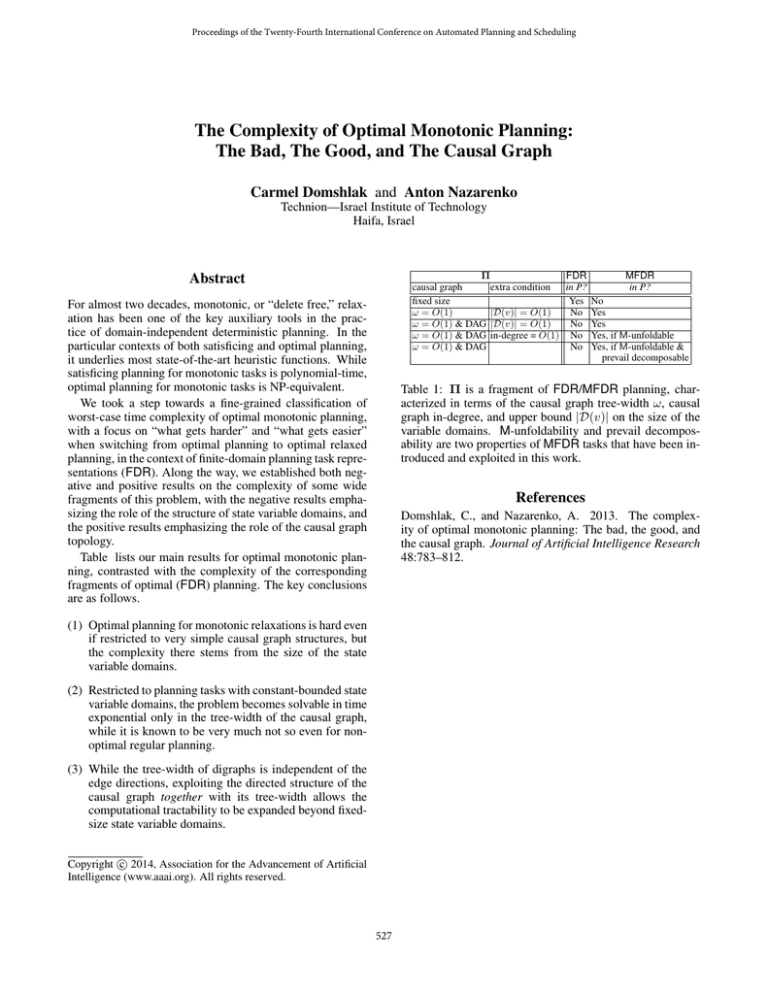
Proceedings of the Twenty-Fourth International Conference on Automated Planning and Scheduling
The Complexity of Optimal Monotonic Planning:
The Bad, The Good, and The Causal Graph
Carmel Domshlak and Anton Nazarenko
Technion—Israel Institute of Technology
Haifa, Israel
Π
FDR
MFDR
causal graph
extra condition
in P?
in P?
fixed size
Yes No
ω = O(1)
|D(v)| = O(1)
No Yes
ω = O(1) & DAG |D(v)| = O(1)
No Yes
ω = O(1) & DAG in-degree = O(1) No Yes, if M-unfoldable
ω = O(1) & DAG
No Yes, if M-unfoldable &
prevail decomposable
Abstract
For almost two decades, monotonic, or “delete free,” relaxation has been one of the key auxiliary tools in the practice of domain-independent deterministic planning. In the
particular contexts of both satisficing and optimal planning,
it underlies most state-of-the-art heuristic functions. While
satisficing planning for monotonic tasks is polynomial-time,
optimal planning for monotonic tasks is NP-equivalent.
We took a step towards a fine-grained classification of
worst-case time complexity of optimal monotonic planning,
with a focus on “what gets harder” and “what gets easier”
when switching from optimal planning to optimal relaxed
planning, in the context of finite-domain planning task representations (FDR). Along the way, we established both negative and positive results on the complexity of some wide
fragments of this problem, with the negative results emphasizing the role of the structure of state variable domains, and
the positive results emphasizing the role of the causal graph
topology.
Table lists our main results for optimal monotonic planning, contrasted with the complexity of the corresponding
fragments of optimal (FDR) planning. The key conclusions
are as follows.
Table 1: Π is a fragment of FDR/MFDR planning, characterized in terms of the causal graph tree-width ω, causal
graph in-degree, and upper bound |D(v)| on the size of the
variable domains. M-unfoldability and prevail decomposability are two properties of MFDR tasks that have been introduced and exploited in this work.
References
Domshlak, C., and Nazarenko, A. 2013. The complexity of optimal monotonic planning: The bad, the good, and
the causal graph. Journal of Artificial Intelligence Research
48:783–812.
(1) Optimal planning for monotonic relaxations is hard even
if restricted to very simple causal graph structures, but
the complexity there stems from the size of the state
variable domains.
(2) Restricted to planning tasks with constant-bounded state
variable domains, the problem becomes solvable in time
exponential only in the tree-width of the causal graph,
while it is known to be very much not so even for nonoptimal regular planning.
(3) While the tree-width of digraphs is independent of the
edge directions, exploiting the directed structure of the
causal graph together with its tree-width allows the
computational tractability to be expanded beyond fixedsize state variable domains.
c 2014, Association for the Advancement of Artificial
Copyright Intelligence (www.aaai.org). All rights reserved.
527




